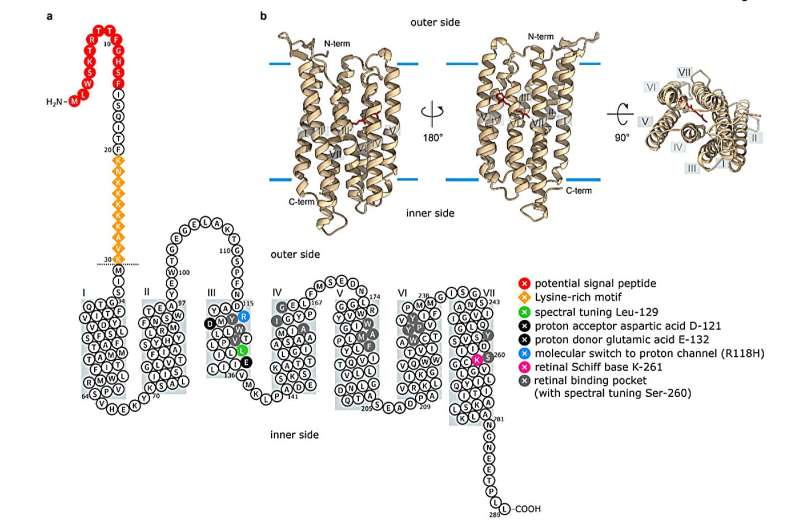This article has been reviewed according to Science X's editorial process and policies. Editors have highlighted the following attributes while ensuring the content's credibility:
fact-checked
peer-reviewed publication
trusted source
proofread
Climate change coping mechanism discovered in algae

One of the building blocks of ocean life can adapt to cope with the effects of climate change, according to new research from the University of East Anglia (UEA).
The discovery holds promises for biotechnology developments that could counter the negative effects of changing environmental conditions, such as ocean warming and even the reduction in the productivity of crops.
Looking at eukaryotic phytoplankton, also referred to as microalgae, found over large parts of the ocean, the international team led by UEA's Prof Thomas Mock discovered the algae have found a way to cope with nutrient starvation, which is predicted to increase due to warming waters. This is good news for the food chain—marine microalgae are the base of the largest food web on Earth including krill, fish, penguins, and whales—as well as pulling CO2 from the atmosphere and producing oxygen.
Thomas Mock, Professor of Marine Microbiology in UEA's School of Environmental Sciences and his former Ph.D. student Dr. Jan Strauss, are the corresponding authors of "Plastid-localized xanthorhodopsin increases diatom biomass and ecosystem productivity in iron-limited surface ocean," which is published in the journal Nature Microbiology.
Prof Mock said, "For algae to produce food and to remove CO2 from the atmosphere, they need sunlight.
"The dilemma, though, is that the cellular machinery for using sunlight requires a lot of iron. However, 35% of the surface of the ocean does not have enough iron to support the growth of algae.
"In these areas algal productivity should be much more reduced, similar to crops on land that lack iron- and nitrogen-rich fertilizer, meaning crops will not grow that well.
"Global warming is increasing drought on land and the same thing happens in the ocean: the warmer the surface water gets, the lower are the nutrients in these surface water layers because of reduced mixing that usually adds nutrients from the deeper ocean. Hence, algae are supposed to starve and therefore produce less food and take up less CO2 from the atmosphere."
The research team discovered that algae have found a way to cope with nutrient starvation, by evolving an additional cellular machinery that allows them to use sunlight for growth without the need for iron.
Dr. Strauss continued the research project while working as a postdoctoral scientist at the European Molecular Biology Laboratory (EMBL) in Hamburg and GEOMAR, Helmholtz Center for Ocean Research in Kiel, Germany.
Dr. Strauss said, "Some groups of microalgae can circumvent photosynthesis by using a light-driven proton pump to fuel growth."
Instead of being reliant on photosynthetic proteins that require iron (to generate ATP, the energy currency of all cells), algae use a light-responsive membrane protein that is related to one in human eyes: rhodopsins. These proteins do not require iron and one specific group of them pumps protons through membranes, which enables synthesis of ATP, which is a main function of photosynthesis in all photosynthetic organisms.
During the collaborative work, Dr. Shiqiang Gao, who is now affiliated with the Department of Neurophysiology at the University of Wuerzburg, cloned these diatom rhodopsins. Dr. Gao confirmed their effective proton pump capabilities, even at low temperatures, using electrophysiological methods after heterologous expression.
Prof Mock said, "This simple cellular machinery is the reason why they still can thrive in these nutrient-poor surface oceans, and it is therefore also likely they will be able to cope with global warming as they are preconditioned."
Potentially, the discovery could be used to enhance the productivity of crops, which also require iron for growth, Prof Mock said.
"This is universal for all primary producers. This machinery can also be used in biotechnology to enhance the productivity of microbes that cannot use light such as yeast. We can modify them so that they can use light for growth, which is desirable in biotechnology, such as the production of insulin, antibiotics, enzymes, antivirals and even biofuel."
The team's work is particularly relevant for the Southern Ocean, which is both the largest iron-limited aquatic ecosystem and among the most productive, supporting the largest populations of algae consumers.
Prof Mock said, "No other habitat on Earth is more important than our oceans for the survival of humans and life in general."
More information: Jan Strauss et al. Plastid-localized xanthorhodopsin increases diatom biomass and ecosystem productivity in iron-limited surface ocean, Nature Microbiology (2023). DOI: 10.1038/s41564-023-01498-5
Journal information: Nature Microbiology
Provided by University of East Anglia





















